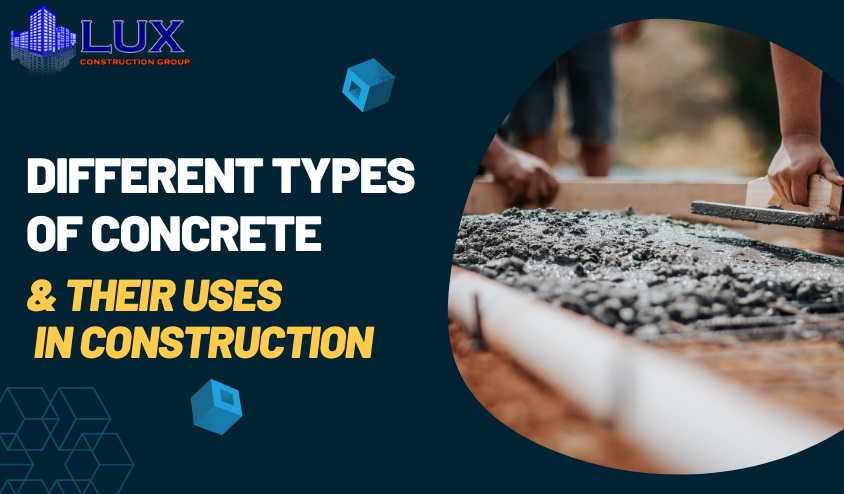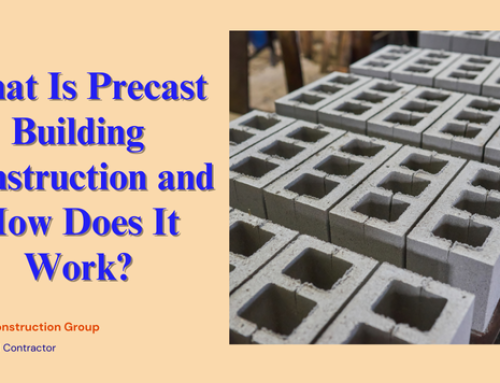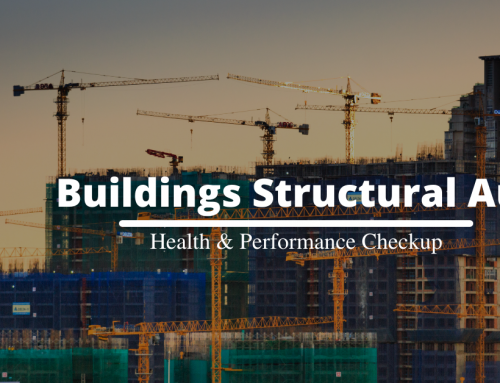Concrete is a versatile building material that can be found in a wide range of structures, from buildings and bridges to walls, swimming pools, roadways, airport runways, floors, patios, and even houses.
Despite its widespread use, the basic formula for concrete is quite simple. It’s made from cement, water, and coarse aggregates. The properties of concrete, such as strength, durability, resistance to heat or radiation, and workability. These are determined by the amount of water and cement used in the mixture.
Fresh concrete can be poured and cast into various shapes and forms, and it can be used for an array of structures such as staircases, columns, doors, beams, lintels, shear walls, unreinforced masonry walls, and more. Concrete is also available in different grades, such as normal, standard, and high-strength, which indicate how much pressure the concrete can withstand and what construction applications it can be used for.
Contents
- What is Concrete and Its Mix Ratio?
- 26 Types of Concrete and Their Uses in Construction
- Normal Strength Concrete
- Reinforced Concrete
- Plain or Ordinary Concrete
- Prestressed Concrete
- Precast Concrete
- Lightweight Concrete
- High-Density Concrete
- Stamped Concrete
- Air-Entrained Concrete
- Ready-Mix Concrete
- Self-Consolidated Concrete
- Volumetric Concrete
- Decorative Concrete
- Polymer Concrete
- Rapid-Set Concrete
- Smart Concrete
- Pervious Concrete
- Vacuum Concrete
- Pumped Concrete
- Limecrete
- Roll Compacted Concrete
- Glass Concrete
- Asphalt Concrete
- Shotcrete Concrete
- High-Strength Concrete
- High-Performance Concrete
- Wrapping Up!
What is Concrete and Its Mix Ratio?
Concrete is a composite material made up of cement, water, and coarse aggregates. When mixed together, these ingredients create a construction material that hardens over time.
The mix ratio of concrete refers to the proportion of these ingredients that are used in the mixture. The most common mix ratio for normal-strength concrete is 1:2:3, which means 1 part cement, 2 parts fine aggregate (such as sand), and 3 parts coarse aggregate (such as gravel or crushed stone) by volume.
However, the mix ratio can vary depending on the desired properties of the concrete and the specific application. For example, a higher cement-to-water ratio will result in a stronger concrete, but will also make the mixture more difficult to work with.
Similarly, a higher aggregate-to-cement ratio will result in a more durable concrete, but will also make the mixture less dense, which can stand still in earthquake areas like California.
The water-cement ratio also plays a key role in concrete properties and strength. A lower water-cement ratio will produce stronger concrete, but also make it more difficult to work with. The water-cement ratio is usually around 0.4-0.5.
It is important to note that the mix ratio alone does not determine the final strength and quality of the concrete. Other factors such as the quality of the ingredients, the proper mixing and curing of the concrete, and the environmental conditions during and after the pour also play a crucial role in the final properties of the concrete.
26 Types of Concrete and Their Uses in Construction
Different types of concrete are available for various applications, depending on the desired outcome. The type of concrete selected can affect its strength, durability, workability, and other properties. It’s important to choose the right type of concrete to meet the specific requirements of your project.
-
Normal Strength Concrete
Normal strength concrete is a mixture of cement, water, sand, and aggregate in a 1:2:4 ratio. It is commonly used for pavements and non-critical buildings, and it can take 30-90 minutes to set depending on weather and cement properties. It is not suitable for structures that require high tensile strength or can withstand wind loading or vibrations.
-
Reinforced Concrete
Reinforced concrete is a type of concrete made stronger by the addition of steel rebar or cables. It is commonly used in the construction of buildings, bridges, and roadways. Reinforced concrete was invented in the 19th century and is now widely used in the construction industry. This is the most common type of concrete to build shear walls in high-rise buildings for seismic earthquake construction.
It is characterized by its ability to withstand compressive and tensile forces. The steel reinforcement helps prevent cracking and breaking. You can often see reinforced concrete with rebar on construction sites.
Also read: Los Angeles Commercial Construction – Permit and Regulations
-
Plain or Ordinary Concrete
Plain or ordinary concrete is a commonly used type of concrete that consists of cement, sand, and aggregates in a 1:2:4 ratio. It is suitable for construction projects that do not require high tensile strength, such as pavements or buildings.
However, it is not as durable as other types of concrete when it comes to vibrations or wind loading. It is also used in dam construction and is known for its satisfactory durability rating.
-
Prestressed Concrete
Prestressed concrete is a type of concrete used for large projects, it is made stronger by applying tension to steel bars or tendons before the concrete is poured.
This technique improves the concrete’s resistance against tensile forces, making it suitable for building bridges, heavy-loaded structures, or roofs with long spans. However, creating prestressed concrete requires specialized skills, and equipment, which is typically done on-site.
-
Precast Concrete
Precast concrete is a type of concrete that is cast and manufactured in a factory, according to specific measurements. It is then transported to the construction site for assembly.
This method is commonly used for items such as concrete blocks, precast walls, staircase units, and poles, and it’s widely seen on highways when being transported to a construction site. The advantage of using precast concrete is its speedy assembly and that they’re of high quality.
-
Lightweight Concrete
Lightweight concrete is a type of concrete that has a lower density than standard concrete, typically less than 1920 kg/m3. It is made by using lightweight aggregates such as Clays, Expanded shales, Scoria, Pumice, Perlite, and Vermiculite.
One of the key properties of lightweight concrete is its low thermal conductivity. It is commonly used in long-span bridges and building blocks, as well as for protecting steel structures.
-
High-Density Concrete
High-density concrete, or heavy-weight concrete, is a specialized type of concrete used in nuclear power plants to resist radiation. It is made with heavy-weight aggregates like Barytes, a barium sulfate mineral, which increases its density and radiation resistance properties.
-
Stamped Concrete
Stamped concrete is a cost-effective, low-maintenance, and durable option for decorative concrete that mimics natural materials such as stone, brick, tiles, etc. It can be used for outdoor surfaces like patios, pool decks, driveways, and interior floors. The patterns and colors can be customized using specialized stamping tools and stains.
The benefits of using stamped concrete include:
- Cost-effectiveness in comparison to natural paving materials and stone.
- Low maintenance requirements once sealed.
- Improved slip resistance when a non-skid additive is used.
- The ability to enhance outdoor spaces and increase property value.
- Durability and longevity.
- A wide variety of patterns and color options to choose from.
Also Read: Restaurant Remodeling Costs Los Angeles
-
Air-Entrained Concrete
Air-entrained concrete is a type of concrete that contains microscopic air pockets to prevent internal pressure and provide space for water expansion when it freezes.
It is made by adding foaming agents such as fatty acids, resins, and alcohols during the mixing process that needs careful supervision. The entrained air makes up 3-6% of the concrete’s volume and is commonly used in freezing environments or areas with freeze-thaw cycles.
-
Ready-Mix Concrete
Ready-mix concrete is a type of concrete that is prepared and mixed in a central plant and then transported to the construction site in large cement trucks. Unlike on-site mixed concrete, ready-mix concrete is mixed according to precise specifications and can be used immediately upon arrival at the site.
The use of ready-mix concrete reduces confusion and increases precision on the worksite and is commonly used for buildings, roadways, walls, and other structures. Retarding agents may be used to delay the setting time of the concrete if the site is too far from the preparation plant.
-
Self-Consolidated Concrete
Self-consolidating concrete, also known as self-compacting concrete, is a highly flowable type of concrete that does not require vibration or mechanical consolidation to fill formwork and encapsulate reinforcement.
This type of concrete is known for its ability to flow and spread easily, making it ideal for use in areas with thick reinforcement or limited access.
Benefits of using self-consolidating concrete include self-leveling properties, improved hardened properties, enhanced consolidation in congested areas, safer work environments, reduced equipment and labor, increased detailing flexibility, smoother surfaces, and reduced noise.
-
Volumetric Concrete
Volumetric concrete is a type of on-site mixed concrete that is delivered using specialized trucks called volumetric mobile mixers. These trucks mix the concrete ingredients and water as needed at the construction site, making it ideal for large sites and multi-projects where different types of concrete are required.
It eliminates the need for multiple deliveries and is an alternative to ready-mix concrete that addresses the challenges of long distances between the concrete plant and construction sites.
-
Decorative Concrete
Decorative concrete is a type of concrete that is designed to enhance the aesthetic appeal of a surface or structure. It can be achieved through various techniques such as coloring, molding, polishing, etching, and applying decorative toppings.
It is suitable for any project that wants to make an aesthetic statement and add a personalized touch to dull surfaces.
-
Polymer Concrete
Polymer concrete is a type of concrete that uses polymer as the binder and high-compressive strength materials such as limestone, silica, quartz, and granite as the aggregate. It’s known for its rapid curing, good adhesion, long-term durability, high strength, low permeability, lightweight formula, and strong chemical resistance.
Polymer concrete is a type of concrete that uses polymer as a binding agent, resulting in rapid curing, good adhesion, durability, high strength, low permeability, a lightweight formula, and strong chemical resistance.
-
Rapid-Set Concrete
If you’re looking for a quick solution, rapid-set concrete is a perfect choice. With faster setting times, it’s ideal for projects that need to be completed quickly.
It’s also highly resistant to low temperatures, making it ideal for use year-round, particularly during the colder winter months when other types of concrete may not be suitable.
-
Smart Concrete
Smart concrete is a new type of concrete technology that uses short carbon fibers to improve the monitoring of reinforced concrete structures. It can detect potential problems by changing its electrical resistance under stress and strain.
It is not yet widely available but it is expected to be a game-changer in cities at high risk of earthquakes, as it allows for quick assessment of structures’ health after seismic events.
-
Pervious Concrete
Pervious concrete is commonly used in road and pavement construction to prevent stormwater runoff by allowing water to pass through it instead of being absorbed.
It offers benefits such as reducing hydroplaning, tire spray, and snow buildup, as well as reducing the need for curbing and storm sewers. It is made of a mixture of cement, water, and coarse aggregates, without sand, which creates an open porous structure, allowing water to pass through quickly.
Also Read: Converting A Residential Property into Dental Clinic
-
Vacuum Concrete
When building structures like deck slabs, parking lots, and industrial floors, concrete may have a higher water content than is required. In such situations, a vacuum pump is used to remove the excess water before the concrete sets. This method is faster than traditional construction and enables the structure to be ready for use sooner.
-
Pumped Concrete
Pumped concrete is a type of cement mixture commonly used in tall buildings for its workability, allowing it to be easily conveyed through a pipe to upper floors. It can also be used for other construction projects such as creating super-flat floors, roadways, bridges, and swimming pools.
It is a reliable, efficient, and economical method of applying concrete, and is often the only way to place it in certain locations. The use of fine aggregates in the mix allows for a smooth flow from the pipe.
-
Limecrete
Limecrete is a type of concrete that utilizes lime as a binding agent instead of traditional cement. Lightweight aggregates, such as glass fiber or sharp sand, are also used in the mix. This type of concrete is commonly used for building floors, vaults, and domes.
One of the main advantages of limecrete is its environmental benefits, as it is easy to clean and is a renewable resource. Additionally, it can also be used in conjunction with radiant floor heating systems.
-
Roll Compacted Concrete
Roll-compacted concrete, commonly seen being compacted by heavy rollers on American highways, is a type of concrete that is ideal for heavy traffic and large loads. It is known for its density and strength and is commonly used in roadways, airport runways, parking lots, pavements, and industrial servicing.
Additionally, it is an environmentally friendly option as it produces fewer emissions during production.
-
Glass Concrete
Glass concrete is a contemporary type of concrete that incorporates recycled glass. This type of concrete is ideal for projects where appearance is a key consideration.
It’s often used in large-scale flooring or decorative façade elements and can be customized by adding colored or shiny glass during the mixing process to give it a unique appearance.
-
Asphalt Concrete
Asphalt concrete, also known as blacktop or asphalt, is a popular choice for constructing pavement on sidewalks, roads, parking lots, airport runways, and highways. Made from a mixture of bitumen and aggregates, it is known for its durability, workability, skid resistance, stability, fatigue resistance, flexibility, and permeability.
As the demand for automobiles increased, so did the demand for asphalt. However, it is important to note that proper design and mixture are crucial for optimal performance. Different mixtures of asphalt are used for different purposes.
-
Shotcrete Concrete
Shotcrete, also known as gunite, is a method of applying concrete where the mixture is shot out of a hose and onto a surface using high-pressure air. This allows for a faster application process and eliminates the need for formwork.
It’s commonly used for repairs on structures made of wood, concrete, or steel, and also in situations where access to the work area is limited or formwork is not practical or cost-effective.
-
High-Strength Concrete
High-strength concrete is a type of concrete that has a tensile strength greater than 40 megapascals (MPa). Hence, it can withstand more stress and pressure than regular concrete. This is used for building foundations, Accessory Dwelling Unit (ADU), Junior Accessory Dwelling Units (JADUs), basement construction and many others.
This makes it ideal for use in civil and commercial construction projects such as buildings and infrastructure, where increased capacity and durability are needed. High-strength concrete is achieved by reducing the water-cement ratio, resulting in a stronger and more durable final product.
-
High-Performance Concrete
High-performance concrete (HPC) is a type of concrete that meets specific efficiency standards.
These standards include easy placement, controlled heat of hydration, adherence to environmental standards, increased longevity and durability, improved mechanical properties over the long term, early strength gain, increased toughness, and favorable permeability and density factors.
It is important to note that while all HPC is considered high-strength, not all high-strength concrete is considered HPC. The strength of HPC may vary depending on the intended application.
Wrapping Up!
The team of LUX Construction Group with over 35 years of experience in the Los Angeles area, provides efficient and cost-effective concrete pumping services to help you achieve your goals. If you need any kind of commercial construction in Los Angeles, we guarantee safe and reliable solutions to suit your needs.
Contact us at (424) 248-5090 for more information or visit our website to fill out a contact form and a member of our team will get back to you promptly.



